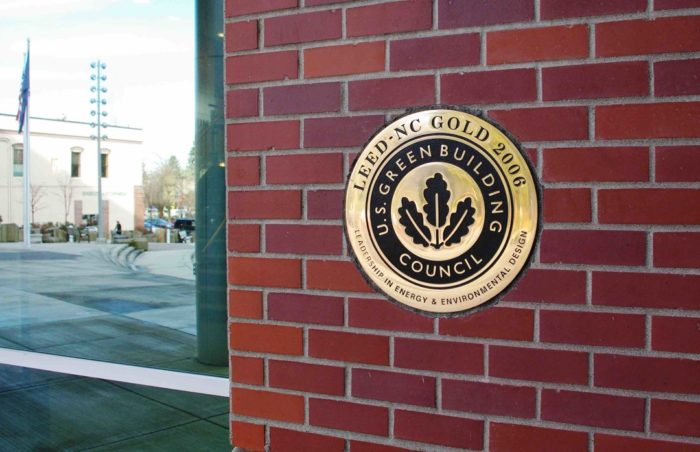
Image Credit: Wikimedia Commons
A couple of weeks ago, the Seattle Daily Journal of Commerce published an opinion piece titled, “Why green building has hit the wall, and what to do about it.” The author, long-time green building advocate Jerry Yudelson, laments the relatively low rate of green building certification and asks, “Why hasn’t the current system had more marketplace success?”
The answer, he claims, is that the most popular rating system, the U.S. Green Building Council’s Leadership in Energy and Environmental Design (LEED) program, is too complicated and costs too much. He points to his own organization’s competing system as “simpler, cheaper and more useful.”
As I wrote last fall, Yudelson’s program has been shown not to be all that “cheap” or “useful.” However, he is right to point out that green building has not gotten as much traction as it should, given its many benefits. Recent reports show that LEED-certified buildings can cut greenhouse gas emissions and water consumption by half, while costing 25 percent less to operate and enjoying nearly 30 percent higher occupant satisfaction and lower interest rates.
If green is so great, why does it account for only one percent of one percent of the total U.S. building stock, according to Yudelson?
Recently, my team and I surveyed hundreds of architects and designers to understand the obstacles to going green. What emerged were six misperceptions about sustainable design.
1. Sustainability equals environmentalism
Conventional wisdom suggests that sustainability deals exclusively with environmental concerns. Wikipedia, for example, defines green building as “environmentally responsible and resource-efficient” structures, and I routinely hear from architects, “My clients aren’t tree huggers.” Yet, the original understanding of sustainability was that it integrates the “triple bottom line” of social, economic, and environmental value — people, profit, and planet.
My colleagues and I created the DART tool to guide designers toward achieving all three values at once. I can think of nothing that doesn’t fall into one or more of those categories. Sustainability encompasses everything.
2. Sustainability equals technology
“A Plan for a Sustainable Future” was the title of the cover story of the November 2009 issue of Scientific American. The subtitle? “How to get all energy from wind, water, and solar power by 2030.” This reflects narrow thinking: The problem is global warming, the cause is emissions from outmoded energy mechanisms, and the solution is smarter mechanisms.
Many architects seem to believe that sustainable design equals solar panels and wind turbines — gizmo green. Technology has hijacked sustainability. “Is it progress if a cannibal uses a fork?” quipped the poet StanisÅ‚aw Jerzy Lec. Often, smarter techniques merely make us better at making things worse. Sustainability is a choice of values, not a choice of tools.
3. Sustainable design costs too much
Perhaps the most common criticism about green building is that it’s too expensive. In a 2008 survey of over 700 construction professionals, 80 percent cited “higher first costs” as the biggest obstacle to green building. Yet, even a dozen years ago the average surcharge for LEED projects was only 2 percent, and the additional investment typically yielded operational savings worth ten times that much, according to a widely cited report back then.
By 2007, studies showed that LEED need not cost more at all. Now green building can actually cost less than conventional construction. By relying more on natural light and outdoor fresh air, the San Francisco Federal Building saved $11 million in mechanical cooling with a total construction cost of 13.5 percent below the market average.
RTKL’s LEED Platinum 1225 Connecticut Avenue, in Washington, D.C., cost about 5 percent below market rate construction in 2009 and sold for the highest rate in the city that year. Lower cost, higher return.
4. Sustainable design takes more time
Architects often complain that green building is too time-consuming. The additional research, analysis and hunt for alternative products simply cannot be done with limited schedules and fees. Yet, the process known as integrated design, which brings together a project’s key stakeholders, designers, consultants and contractors early to get consensus on goals, actually can save time by ensuring more thorough coordination and avoiding costly changes later.
When RTKL designed the federal government’s largest LEED Gold office building to date, the team completed the design nearly a year ahead of schedule, and construction finished four months more quickly than expected, saving millions in escalation costs. Sustainable design can lead to a better product faster.
5. Sustainability isn’t about design
Some of the most celebrated architects dismiss sustainability because, in the words of National Design Award winner Peter Eisenman, it “has nothing to do with architecture.” Performance specifications are hidden in the technical manual, not visible on the napkin sketch.
Yet, basic decisions about a design’s shape have a significant impact on both the resources needed and the people who use it. It’s been estimated that 80 to 90 percent of the impact of a building or product is determined in the earliest stages of development: When just 1 percent of a project’s up-front costs are spent, up to 70 percent of its life-cycle costs have been committed already. As the expression goes, “All the really important mistakes are made on the first day.”
6. Sustainable design isn’t beautiful
“Some of the worst buildings I have seen are done by sustainable architects,” Eisenman has grumbled. Famed architect Rafael Viñoly has said, “Sustainability has, or should have, no relationship to style.” Designers care about image, and the green movement, like it or not, has a reputation for being all substance and no style — ethics without aesthetics.
Yet, as I argue in my book, The Shape of Green: Aesthetics, Ecology and Design (Island Press, 2012), the “look and feel” of design are essential to sustainability. If design doesn’t appeal to the senses, it’s destined to be discarded.
“In the end,” writes Senegalese poet Baba Dioum, “We conserve only what we love.” We don’t love something because it’s nontoxic and biodegradable — we love it because it moves the head and the heart. Following the lessons of sustainability to their logical conclusion will inspire more designers to reconsider the impact of every decision, including form and image. We can be as smart about the way things look as we’re becoming about the way they work.
Lance Hosey, an architect and author, is chief sustainability officer with the design firm RTKL. This post originally appeared at The Huffington Post and is used here with permission of the author.
Weekly Newsletter
Get building science and energy efficiency advice, plus special offers, in your inbox.





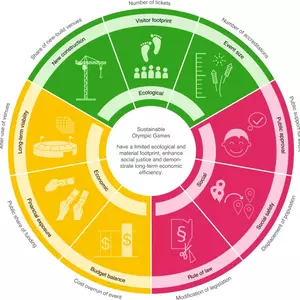
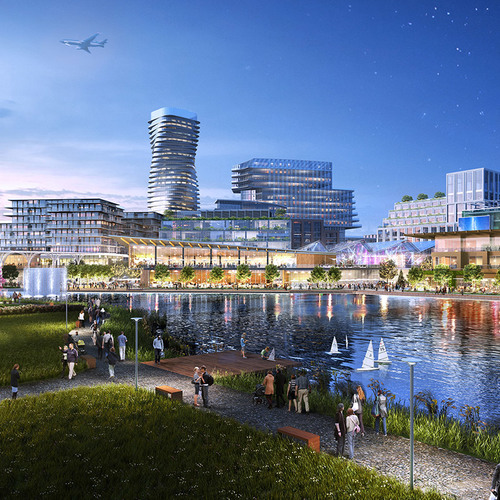
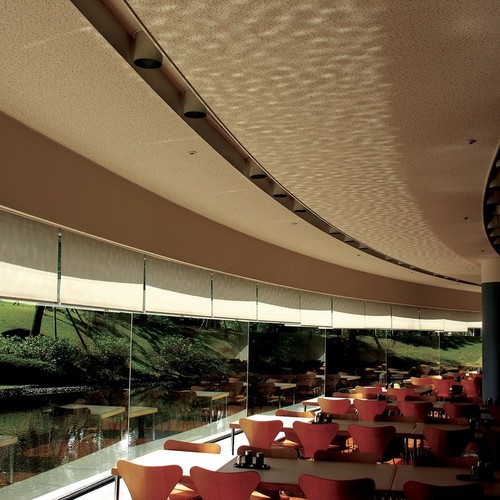
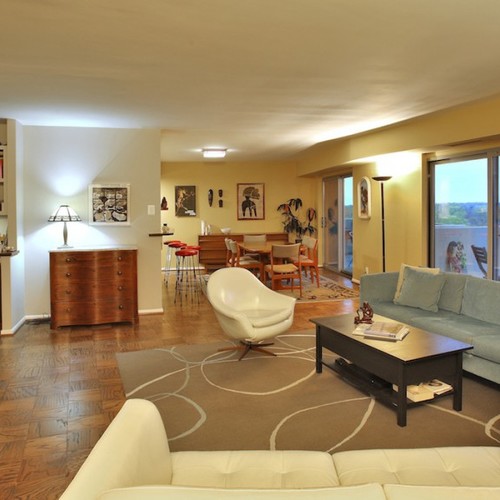






18 Comments
lots more green houses
Just because people don't bother with LEED, PH, Energy Star, etc. certifications, that doesn't mean there aren't many energy efficient, sustainable houses being built.
For me, the bother and cost of getting a certification isn't worth it. My almost finished house meets PH air tightness standard. Insulated with R-42 walls and R-70 roof, it will use very little energy for heating in my Maine climate. It has PH certified windows and doors. PV on the roof should generate enough electricity to bring me pretty close to net zero. Highly efficient minisplits for heat. Zehnder HRV.
There are many similar houses being built. Just because we don't bother with certification, it doesn't mean we aren't building green. I'm thinking I'll post my annual energy bill on a plaque on the wall.
I think programs like PH are highly valuable, because someone has done the analysis and collected the data that the rest of us can use.
When net zero becomes code-min...
... they just call it a "house", not a green house, or Net Zero Energy house or R2000 or a certificatied blah-blah house. Net Zero energy will become code for all new residential homes in CA in 2020.
"Net-Zero-capable" is currently code-min in Austin Texas, and will be cheap to take the rest of the way in short years when rooftop PV drops below the $2/watt installed cost price point.
Lamenting the low numbers of certifications to some standard or another isn't really called for. While some certification standards had an educational purpose when originally framed, they have succeeded in moving the code-minimum bar, and have brought other lessons to bear for those who want to go beyond code-min. The branding cache' of certification hasn't proven to have sufficient value to developers for them to feel it's worth the overhead for getting those certifications. Some are happy to certify one or two projects for marketing purposes as a means of demonstrating their level of understanding of what it takes, but certifying every project is rarely deemed "worth it".
Leadership?
The question becomes if the vast majority of builders and developers aren't taking the intiative to achieve certification( I could care less about certification but it exemplifies most current building practice) of any kind and still continue to build code minimum level houses, who should take lead us to where we need to go. Clearly buyers, and "market forces" are not producing much of an overall change on a national scale toward more sustainable building. Something like over 90% of new homes built still use fiberglass batt insulation
So if market forces are not going to result in a change of substandard building is it time for federal government to step in? Aggressive national benchmarks ? i don't know if states like Florida where it is now illegal to mention "climate change" in state literature can be depended upon.
Sustainability
A thoughtful and interesting article. However I'm not sure I really understand what is meant by sustainability, or perhaps even how useful the term is, if as he says: "sustainability encompasses everything".
Beauty in the Eye
It would be interesting to see examples of the buildings considered beautiful by Eisenman, and others who object to sustainable design for aesthetic reasons. My experience is the opposite of his quote. Most of the worst buildings that I have seen, in both aesthetics and user satisfaction, are done by architects who are paying no attention to sustainability.
Certification matters
Certification marks a certain standard that can be documented. Just building a home to be "green" can mean anything and everything. Installing CFLs bulbs and then using fiberglass batts in a leaky wall assembly can be called "green" and an "energy efficient" building by whoever wants to call it that.
Certifications are common place in every other field of science. Why not building science?
Vehicle manufacturing, vehicle safety, window efficiency NFRC, AAMA, etc., EPA air pollution ratings, civil engineering, structural engineering, architectural, ASHRAE, etc. Engine designs are SAE certified to show the HP and Torque of an engine. Prior to that it was a free-for-all and manufacturers were making insane albeit false HP claims like they did in the 60's and early 70's.
Certification sets a goal and then it is up to the participant to reach or not reach that goal. Human beings are predictable in that if they are not given a set goal, they tend to wander aimlessly. It's part of basic human psychology. Everyone has heard the statement "set goals" and it is a simple but important statement. No goals usually equals stagnation.
Building codes are a form of "certification" in that in order for a home or building to receive "certification of occupancy" one must meet the standards (goals) set forth by that code. If they are not met, no certification of occupancy is given. LEED, Passive House, Energy Star, Net Zero, etc., are certifications that set the goal above and beyond code minimum. It also allows a way for stats to be gathered. If you build a home above and beyond code minimum there is NOT WAY to track that information. Your R-40 walls and R-70 ceiling home just gets thrown in the bin of "code minimum" built homes. One might not care but there is no way to document that build and it gets lost in the stats as just another code min home.
Another factor to consider is when/if you sell your home or insure your home. The specific buyer will be drawn to a LEED or Passive House that is certified. Otherwise it is just another code min home.
Insurance breaks
Are there insurance companies that give lower rates for Leed or Passive House certification?
Response to Malcolm Taylor (Comment #4)
Malcolm,
When I read this piece, I had the same reaction you did (to the repeated use of the word "sustainability").
No architect or builder knows whether the planet can support continued development of new buildings forever; in that sense, declaring that one's construction methods are "sustainable" is an act of hubris. The planet will get the last laugh, I fear.
Perhaps "sustainable" is just shorthand for "complying with the requirements of the LEED standard."
Malcolm
Malcolm,
Yes, companies like Farmers Insurance will give a reduction in the annual rates you pay if the home is LEED certified or Passive House certified. They will also give discounts for Energy Star and other green certifications.
Certification Matters - Part 2
Another reason why certification matters is with appraisals. A home that is certified will appraise higher than an exact home in the exact area that is not certified. The certification brings validity and statistical proof and valuation that it was built with a higher standard and materials.
So if you stuff the walls with R-60 insulation, have a R-100 roof, get less than 0.20 ACH on the blower door, etc., but never certify it, it means nothing to the appraiser or the insurance company. Your home is no different than the home with R-13 batts and R-38 roof with leaky walls. The appraiser will value your energy home like they would the leaky energy hog down the street.
Buildings have nothing to do
Buildings have nothing to do with a sustainable planet for humans. Nothing.
Did you have lots of offspring?
Do you support a church that promotes unlimited offsprings to grow their church domination over competing religions?
Do you send money to save the masses when mother nature tries to clean up a few million overpopulated acres of the planet?
Growing an economy to pay off overspending is a worldwide attitude that is the norm. Growth fueled by more people, how many countries fear having no youth to pay for the cost of elders leaving the work world?
Tech can get us through for now. And someday when tech has no use for too many humans.... it will eliminate those of it's choosing. Maybe you. Maybe me.
aj
Batt insulation is the problem? Almost laughed my coffee all over my batty self.
Certification Matters - Part 3
In addition, through the Zero Energy Ready Home Lender Partner progam, the U.S. DOE is identifying and promoting financial institutions that offer green mortgage appraisals to certified homes under the DOE Zero Energy Ready Home, EPA ENERGY STAR Certified Home, and PHIUS+ programs.
Daylighting at SF Federal Building
There are some things to like about the San Francisco Federal Building. However, claims regarding energy savings from daylighting have not played out as anticipated. The architects admitted too much direct beam sunlight. Roller blinds have been retrofitted and daylight only serves the perimeter zone, not the core as originally intended. See https://escholarship.org/uc/item/0vd3q8s2#page-1 for a Ph.D. thesis on this topic by Kyle Konis.
In April 2012, in an article titled Doing Daylighting Right, Paula Melton of Environmental Building News wrote:
When the San Francisco Federal Building opened in March 2007, its tower received lavish praise and awards for offering views and operable windows at almost every workstation. The design team seemed to have done everything right, offering an east-west orientation, slender profile, and both horizontal and vertical shading devices on the exterior. But a year later, a local newspaper declared it “San Francisco’s green building nightmare.” Problems with glare and overheating had to be addressed with window film and operable shades. Many occupants in perimeter areas still report visual discomfort despite these additions, while those working near the core of the building have to keep their lights on all day, according to research completed by Kyle Stas Konis, a doctoral candidate at the University of California–Berkeley architecture program. “These results bring into question the efficacy of a number of daylighting strategies implemented,” Konis wrote in his dissertation.
Paula gives the architects too much credit. They didn't do everything right. They used clear glass and a metal screen on the exterior as a shading device. The result was too much light and really bad glare. I personally do NOT use this building as an example of good daylighting!
Sustainability... is it like "Diversity" or "Social Justice"?
Words that everybody "know" the meaning of, until you ask them to define them.
Sustainability is a tough nut to crack
Sustainability can be measured in "embodied energy" and "cradle to grave" environmental impact. Bamboo may be a wonderfully sustainable material for flooring, however, if it has been shipped 3000 miles on a cargo ship burning #6 bunker oil, it loses it's lustre.
Sustainability
Sustainability is nothing more and nothing less than the challenge of incorporating human civilization into the naturally-existing flows of energy and resources that make up the natural world.
Ecology tells us that the beauty, resilience, and fecundity of nature is based on a host of cycles: the water cycle, the nitrogen cycle, the carbon cycle, food webs, predator-prey relationships. The details change but the cyclic nature of these resource flows do not. When the cycles stop, things break, ecosystems simplify, species go extinct, and ecosystem services are lost.
Industrial civilization by contrast is based on linear flows, from source to sink. Resources are mined, transformed, and (for the most part) ultimately buried or burned. Ancient energy sources are dug up and transformed to free carbon and heat.
The challenge of sustainability is to transform these linear patterns of extraction and consumption so that they more closely resemble those in nature, and in ways that do not disrupt (or ideally, actively enhance) these natural cycles. If we succeed, human civilization will start to look very much like any other ecosystem
Response to Brent Eubanks
Brent,
So, given your definition -- a valid one -- can any architect or builder lay claim to the use of the adjective "sustainable" to describe their buildings? I think not...
Verifiable Energy-Efficiency - Starts With Design
Apologies beforehand to the venerable architect, Peter Eisenman. I realize he was not quoted directly, but the inference that sustainability "has nothing to do with architecture", is unfortunate no matter who believes it.
Ok, it depends on how the words 'sustainability' and even 'architecture' are defined. So allow me a question and a few observations. What is more important than real energy consumption in terms of sustainability? It's a fact that the lion share of a LEED certification surrounds energy efficiency and even more so with the countless other "green" programs. Of course the HERS Index is solely the measure of relative energy-efficiency. So I could make an argument that sustainability depends upon a lot on measurable energy-efficiency.
I'm not an architect but I am a home designer, one that specializes in super energy-efficient, hi-performance homes. So, wanting to respectfully put my objection to Mr. Eisenman's comment in context, I think most would agree that homes can be defined as architecture, graciously speaking!
Now to the point. My company, Energy Smart Home Plans offers home designs with the entire mechanical system within conditioned space. Yes, even one-story homes on a slab foundation. Imagine good looking and thoughtfully designed, super energy-efficient homes that aren't costly metal & glass boxes! Builders who for the first time build our homes have reported HERS Index numbers in the high 40's, without PV. We have 2000 sq. ft. homes operating very comfortably on electricity costs of $630 ANNUALLY. That's under $53/month. Again, without solar PV. Surprise, no spray foam insulation required either.
Addressing the 'high cost of green', my local Habitat 4 Humanity affiliate is building homes we designed for them with ducts in conditioned space, for all of $43/ft. The homes live quite comfortably on just one ton of air per 1000 AC sq. ft. Now I'm not 100% sure these homes boast the lowest H4H energy costs nationally, but they'll be very close!
You might argue that energy-efficiency does not equate to sustainability, but to say that neither has to do with architecture...I'll be polite and say, "you should see what's happening out here!"
Log in or create an account to post a comment.
Sign up Log in